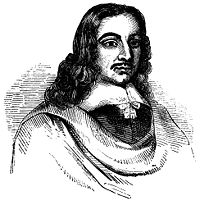John Gadbury

John Gadbury (1627–1704) was an English astrologer, and a prolific writer of almanacs and on other related topics. Initially a follower or disciple, and a defender in the 1650s, of William Lilly, he eventually turned against Lilly and denounced him in 1675 as fraudulent.[1]
His 1652 work Philastrogus Knavery Epitomized was a reply to Lillies Ape Whipt by the pseudonymous Philastrogus,[2] defending Lilly, Nicholas Culpeper and others.
His father William was an estate worker for Sir John Curson of Waterperry House near Wheatley, Oxfordshire, who eloped with Frances, a daughter of the house, a year before John's birth. However, John Gadbury persuaded his grandfather Sir John to put him through Oxford, before his astrological training.
He became a High Tory and Catholic convert. He had a number of brushes with the authorities: imprisonment (wrongful) at the time of the Popish Plot and suspicion later of plotting against William III of England; also trouble for omitting Guy Fawkes Day from his almanacs. He feuded with fellow astrologer John Partridge, a supporter of the Whigs.[3]
Sources
- Concise Dictionary of National Biography
Notes
- ^ David Plant, "John Gadbury: Politics and the Decline of Astrology", in The Traditional Astrologer Magazine, issue 11, Winter 1996, accessed Sept. 20, 2011
- ^ It is now often suggested that Philastrogus was Robert Lilburne.
- ^ Burns, William (2005). "Astrology and Politics in Seventeenth-Century England: King James II and the Almanac Men". The Seventeenth Century. 20 (2): 242–253. doi:10.1080/0268117X.2005.10555559. S2CID 159634917. ProQuest 216247503 – via Proquest.
